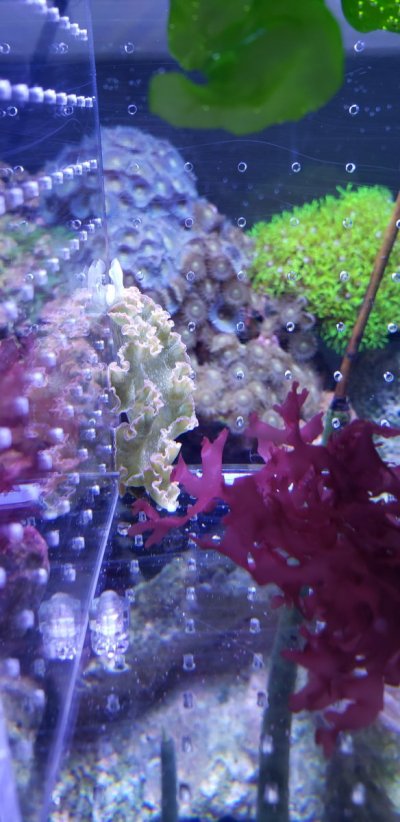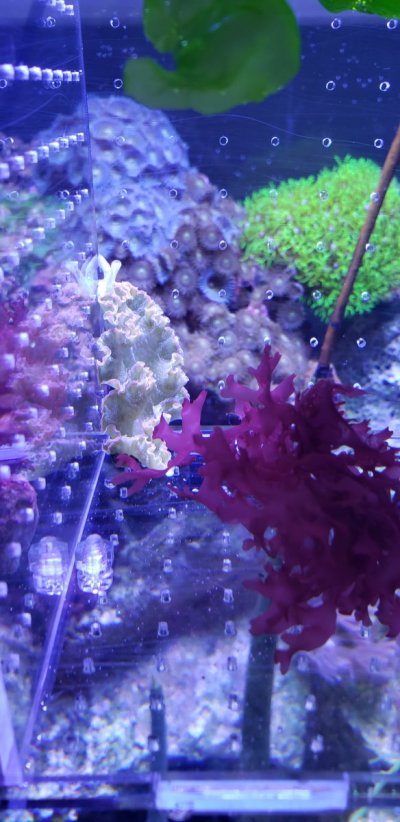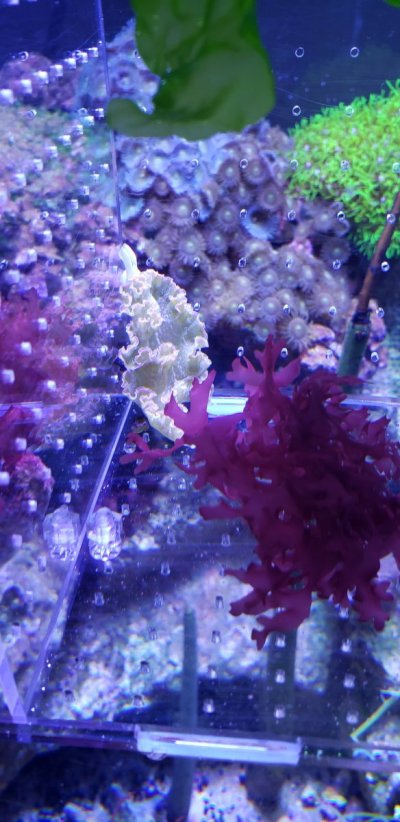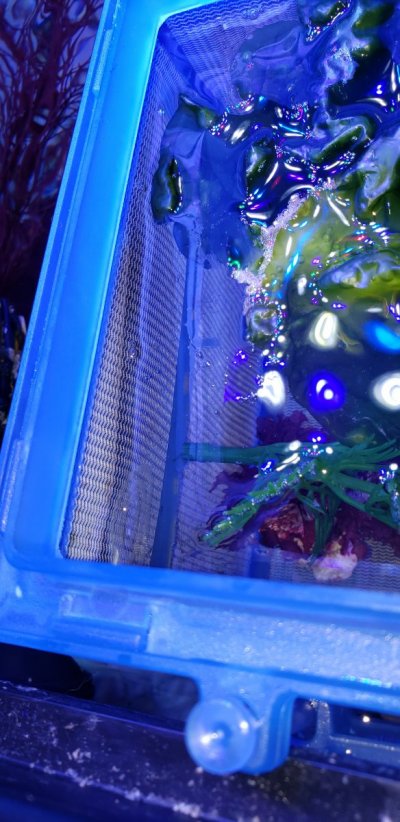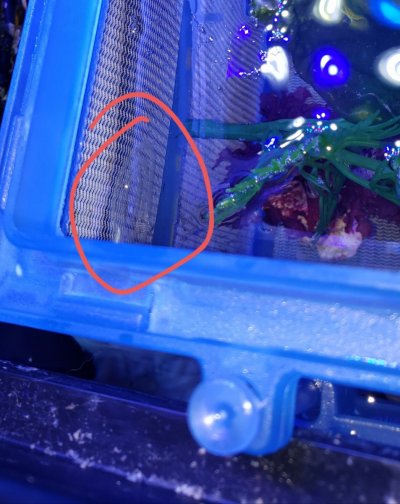Observational data
Locomotion: Like many snails and slugs the Elysia Crispata moves with a singular foot. Like most Elysia, they lack the ability to cling to a surface, instead they prefer to glide in low flow zones and will secrete a thin, and nearly invisible, thread of slime that it will use when dislodged, to reattach its self to a semi rigid surface. Like many other marine slugs, the Crispata will cling to the surface of the water column when in extremely low flow. Why this behavior occurs is a complete mystery to me, I personally see no benefit on most species, however it by all accounts, appears to be an intentional action. Another interesting observation: I recently observed multiple Crispata moving from a higher area in the water column to the bottom using their invisible mucal secretions, the grace in which this was done leads me to believe it's a natural method of movement.
Diet: The Elysia Crispata is a suctorial feeder, that means it literally sucks out the contents of its chosen meal from the inside out. But these strange little creatures kick it up a notch (no not the bearded swede). The Crispata will suck out the algae cells whole and then by means not quite understood, they separate the chloroplasts and send them to their Parapodia where they are used to allow the slug to photosynthesize. As such, they should be considered photosyenthitic when keeping them, however photosynthesis is not enough to sustain them.
From research I have seen, the Crispata will choose specific calcified macroalgae in their pre calcified state, and feed on them until the algae reaches the season it becomes completely calcified, at this point the Crispata will rely primarily on the stored Chloroplasts.
Here are a list of algae I have observed these slugs eating:
Caulerpa Sertularoides
Caulerpa Ashmeadii
Caulerpa Racemosa
Caulerpa microphysa
Caulerpa Verticalata
Gracilaria Parvispora (requires further data)
Bryopsis
(more algae tests to come)
They will NOT feed on most strains of turf and hair algae. Nor do I recommend they be used as cleaners without protecting pumps and intakes.
Breeding: They will spawn in the right conditions. The conditions I have observed are :
Temp: 84-87F
Salinity: 1.027-1.033
Light Cycle: 12 on 12 off... some will understand why that's peculiar
Other ranges did not have any affect on spawning however long term data is pending. Egg viability data to be provided by Nov.
Lifespan: Data pending. By the time they make it to retail they generally have a lifespan of 1-5 months. Upon (natural) death they will disintegrate in to a foul smelling slime, however when they are killed they rapidly disintegrate in to a VERY foul smelling and toxic slime. Inverts attempting to eat the corpse of a slug killed by a salinity shift either died or ran off rapidly. The smell when removed is reminiscent of paint thinner mixed with a briny dead snail smell. Very unpleasant.
Tolerated water parameters.
Salinity: 1.023-1.045
Nitrate: 80ppm
Phosphate : 5.0ppm
Viability in a mixed reef: Fairly limited, they tend to get blown around by powerheads until they are sucked in to the overflow or an angry powerhead. Curious fish will peck at them repeatedly, they are easily lost.
Viability in a species only/macro/nano: Excellent, overflows are easily screened and pumps can be covered and set to lower flow rates. They require food more than light however they will benefit from red spectrum heavy lighting such as a grow light or even direct sunlight. Food intake can be controlled and monitored, they are a fairly forgiving animal when given food and low flow.
Locomotion: Like many snails and slugs the Elysia Crispata moves with a singular foot. Like most Elysia, they lack the ability to cling to a surface, instead they prefer to glide in low flow zones and will secrete a thin, and nearly invisible, thread of slime that it will use when dislodged, to reattach its self to a semi rigid surface. Like many other marine slugs, the Crispata will cling to the surface of the water column when in extremely low flow. Why this behavior occurs is a complete mystery to me, I personally see no benefit on most species, however it by all accounts, appears to be an intentional action. Another interesting observation: I recently observed multiple Crispata moving from a higher area in the water column to the bottom using their invisible mucal secretions, the grace in which this was done leads me to believe it's a natural method of movement.
Diet: The Elysia Crispata is a suctorial feeder, that means it literally sucks out the contents of its chosen meal from the inside out. But these strange little creatures kick it up a notch (no not the bearded swede). The Crispata will suck out the algae cells whole and then by means not quite understood, they separate the chloroplasts and send them to their Parapodia where they are used to allow the slug to photosynthesize. As such, they should be considered photosyenthitic when keeping them, however photosynthesis is not enough to sustain them.
From research I have seen, the Crispata will choose specific calcified macroalgae in their pre calcified state, and feed on them until the algae reaches the season it becomes completely calcified, at this point the Crispata will rely primarily on the stored Chloroplasts.
Here are a list of algae I have observed these slugs eating:
Caulerpa Sertularoides
Caulerpa Ashmeadii
Caulerpa Racemosa
Caulerpa microphysa
Caulerpa Verticalata
Gracilaria Parvispora (requires further data)
Bryopsis
(more algae tests to come)
They will NOT feed on most strains of turf and hair algae. Nor do I recommend they be used as cleaners without protecting pumps and intakes.
Breeding: They will spawn in the right conditions. The conditions I have observed are :
Temp: 84-87F
Salinity: 1.027-1.033
Light Cycle: 12 on 12 off... some will understand why that's peculiar
Other ranges did not have any affect on spawning however long term data is pending. Egg viability data to be provided by Nov.
Lifespan: Data pending. By the time they make it to retail they generally have a lifespan of 1-5 months. Upon (natural) death they will disintegrate in to a foul smelling slime, however when they are killed they rapidly disintegrate in to a VERY foul smelling and toxic slime. Inverts attempting to eat the corpse of a slug killed by a salinity shift either died or ran off rapidly. The smell when removed is reminiscent of paint thinner mixed with a briny dead snail smell. Very unpleasant.
Tolerated water parameters.
Salinity: 1.023-1.045
Nitrate: 80ppm
Phosphate : 5.0ppm
Viability in a mixed reef: Fairly limited, they tend to get blown around by powerheads until they are sucked in to the overflow or an angry powerhead. Curious fish will peck at them repeatedly, they are easily lost.
Viability in a species only/macro/nano: Excellent, overflows are easily screened and pumps can be covered and set to lower flow rates. They require food more than light however they will benefit from red spectrum heavy lighting such as a grow light or even direct sunlight. Food intake can be controlled and monitored, they are a fairly forgiving animal when given food and low flow.






